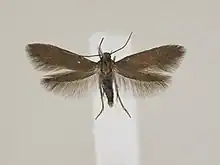| Epermenia profugella | |
|---|---|
 | |
| Scientific classification | |
| Domain: | Eukaryota |
| Kingdom: | Animalia |
| Phylum: | Arthropoda |
| Class: | Insecta |
| Order: | Lepidoptera |
| Family: | Epermeniidae |
| Genus: | Epermenia |
| Species: | E. profugella |
| Binomial name | |
| Epermenia profugella | |
| Synonyms | |
| |
Epermenia profugella, also known as the little lance-wing is a moth of the family Epermeniidae found in northern, central and eastern Europe.[2] The moth was first described by Henry Tibbats Stainton in 1856, from a specimen found in Kemsing, Kent, England.[3]
Description
The wingspan is 8–10 mm.[4] The forewings are dull greyish bronze, tinged with fuscous and the hindwings are dark grey.[5]
Ova, are probably laid on the seeds of ground-elder (Aegopodium podagraria), angelica (Angelica sylvestris), wild carrot (Daucus carota) and burnet-saxifrage (Pimpinella saxifraga).[6] The larvae feed within the seeds, spinning two or three together during September and October. Feeding is inconspicuous, but larvae can sometimes be seen on the outside of seeds.[3] The species overwinters in the pupal stage within a flimsy cocoon on the ground.[7][3]
References
- ↑ "Epermenia (Cataplectica) profugella (Stainton, 1856)". Fauna Europaea. Retrieved 6 October 2020.
- ↑ Faunistics of the Epermeniidae from the former USSR (Epermeniidae) Archived 2013-12-03 at the Wayback Machine
- 1 2 3 Godfray, H C J; Sterling, P H (1996). Epermeniidae. In Moths and Butterflies of Great Britain and Ireland. Volume 3. Colchester: Harley Books. p. 119. ISBN 0-946589-56-9.
- ↑ "Epermenia profugella (Stainton, 1856)". Swedish Moths. Retrieved 6 October 2020.
- ↑ "Epermenia profugella (STAINTON, 1856) - Bibernellen-Zahnflügelfalter". lepiforum.de. Retrieved 6 October 2020.
- ↑ Ellis, W N. "Epermenia profugella (Stainton, 1856)". Plant Parasites of Europe. Retrieved 6 October 2020.
- ↑ "47.008 [B&F: 0480] Epermenia profugella (Stainton, 1856)". Hants Moths. Retrieved 6 October 2020.